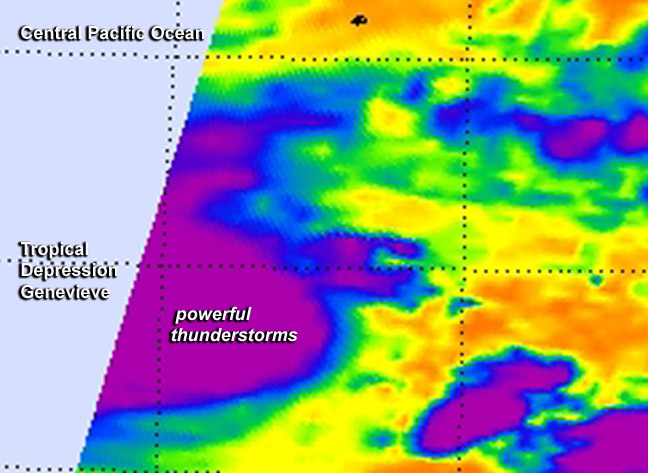NASA Sees Bursts of Thunderstorms in Tropical Depression Genevieve's Center

This false-colored infrared image from NASA's Aqua satellite shows powerful thunderstorms (purple) re-developed around Genevieve's center on August 5 at 8:35 a.m. EDT. Image Credit: NASA JPL, Ed Olsen
A false-colored infrared image created at NASA's Jet Propulsion Laboratory in Pasadena California used data from the Atmospheric Infrared Sounder (AIRS) instrument that flies aboard NASA's Aqua satellite.
The AIRS data showed powerful thunderstorms re-developed around Genevieve's center on August 5 at 8:35 a.m. EDT. That's an indication that there's some punch left in the storm, and that punch could help it strengthen, according to the Central Pacific Hurricane Center (CPHC).
In the August 5 discussion about Genevieve, the CPHC noted “Genevieve has continued to present a bursting pattern during the overnight hours…with the low level circulation center estimated to be under the southeastern portion of an area of very cold cloud tops.”
At 11 a.m. EDT (1500 UTC) today, Tuesday, August 5, Genevieve's maximum sustained winds were near 35 mph (55 kph). The NOAA Central Pacific Hurricane Center notes that gradual strengthening is forecast today through Wednesday, and Genevieve may become a tropical storm later today.
The center of tropical depression Genevieve was located near latitude 11.1 north, longitude 171.1 west. That's about 1,120 miles (1,805 km) southwest of Honolulu, Hawaii and 400 miles (645 km) south-southwest of Johnston Island.
The depression is moving toward the west-northwest near 14 mph (22 kph) and this motion is expected to continue today through Wednesday. The estimated minimum central pressure is 1005 millibars.
NOAA's CPHC calls for slow intensification over the next couple of days as the storm continues to track in a westerly direction. Genevieve is expected to cross the International Date Line in a couple of days and when it does the forecast management of the storm would covered by the Joint Typhoon Warning Center.
Text credit: Rob Gutro
NASA's Goddard Space Flight Center
Media Contact
More Information:
http://www.nasa.gov/content/goddard/genevieve-eastern-pacific-ocean/All latest news from the category: Earth Sciences
Earth Sciences (also referred to as Geosciences), which deals with basic issues surrounding our planet, plays a vital role in the area of energy and raw materials supply.
Earth Sciences comprises subjects such as geology, geography, geological informatics, paleontology, mineralogy, petrography, crystallography, geophysics, geodesy, glaciology, cartography, photogrammetry, meteorology and seismology, early-warning systems, earthquake research and polar research.
Newest articles

Properties of new materials for microchips
… can now be measured well. Reseachers of Delft University of Technology demonstrated measuring performance properties of ultrathin silicon membranes. Making ever smaller and more powerful chips requires new ultrathin…

Floating solar’s potential
… to support sustainable development by addressing climate, water, and energy goals holistically. A new study published this week in Nature Energy raises the potential for floating solar photovoltaics (FPV)…

Skyrmions move at record speeds
… a step towards the computing of the future. An international research team led by scientists from the CNRS1 has discovered that the magnetic nanobubbles2 known as skyrmions can be…




















